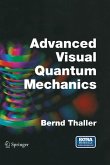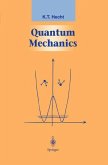"Visual Quantum Mechanics" uses the computer-generated animations found on the accompanying material on Springer Extras to introduce, motivate, and illustrate the concepts explained in the book. While there are other books on the market that use Mathematica or Maple to teach quantum mechanics, this book differs in that the text describes the mathematical and physical ideas of quantum mechanics in the conventional manner. There is no special emphasis on computational physics or requirement that the reader know a symbolic computation package. Despite the presentation of rather advanced topics, the book requires only calculus, making complicated results more comprehensible via visualization. The material on Springer Extras provides easy access to more than 300 digital movies, animated illustrations, and interactive pictures. This book along with its extra online materials forms a complete introductory course on spinless particles in one and two dimensions. The use of visualization techniques greatly enhances the understanding of quantum mechanics as it allows us to depict phenomena that cannot be seen by any other means. "Visual Quantum Mechanics" uses the computer generated animations found on the extra material on Springer Extras to introduce, motivate, and illustrate the concepts explained in the book. For example, by watching QuickTime movies of the solutions of Schroedinger's equation, students will be able to develop a feeling for the behavior of quantum mechanical systems that cannot be gained by conventional means. While there are other books on the market that use Mathematica and Maple to teach quantum mechanics, this book differs in that the text describes the mathematical and physical ideas of quantum mechanics in the conventional manner, with no special emphasis on computational physics or the requirement that the reader know a symbolic computation package or Mathematica.
In this book, instead, the computer is used to provide easy access to alarge collection of animated illustrations, interactive pictures, and lots of supplementary materials. "Visual Quantum Mechanics" takes a mathematical rather than a physical approach to quantum mechanics, and includes results more typical in more advanced books but which are more comprehensible via visualization. Despite the presentations of advanced results, the book requires only calculus, and the book will fill the gap between classical quantum mechanics texts and mathematically advanced books. The book will have a home page at the author's institution which will include supplementary material, exercises and solutions, additional animations, and links to other sites with quantum mechanical visualization. This book along with its extra materials on Springer Extras, which contains over 300 digital movies, form a complete introductory course on spinless particles in one and two dimensions. There is a second book in development which will cover such topics as spherical symmetry inthree dimensions, the hydrogen atom, scattering theory and resonances, periodic potentials, particles with spin, an relativistic problems (the Dirac equation).
In this book, instead, the computer is used to provide easy access to alarge collection of animated illustrations, interactive pictures, and lots of supplementary materials. "Visual Quantum Mechanics" takes a mathematical rather than a physical approach to quantum mechanics, and includes results more typical in more advanced books but which are more comprehensible via visualization. Despite the presentations of advanced results, the book requires only calculus, and the book will fill the gap between classical quantum mechanics texts and mathematically advanced books. The book will have a home page at the author's institution which will include supplementary material, exercises and solutions, additional animations, and links to other sites with quantum mechanical visualization. This book along with its extra materials on Springer Extras, which contains over 300 digital movies, form a complete introductory course on spinless particles in one and two dimensions. There is a second book in development which will cover such topics as spherical symmetry inthree dimensions, the hydrogen atom, scattering theory and resonances, periodic potentials, particles with spin, an relativistic problems (the Dirac equation).
From the reviews "The new introductory textbook by Bernd Thaller, Visual Quantum Mechanics, has two distinctive features, a well-produced CD-ROM, and an emphasis on dynamics. These two features work together well and make for a remarkable publication, which mathematically oriented readers will appreciate for the care it takes with rigorous aspects of physics. (...) It is the CD-ROM which makes the book. (...) Thaller has provided 137 modules illustrating different topics (...) I would venture to say that not only the beginning student, but even the seasoned scientist may benefit, by getting a clue to a new phenomenon or theorem. (...) In sum, Visual Quantum Mechanics can be profitably used as a major supplement in an undergraduate course on quantum mechanics, and it will certainly enliven the curriculum. It could be a superb stand-alone text in a short physics course or a seminar for mathematically oriented students." Evans M. Harrell II in: SIAM Rezension.








